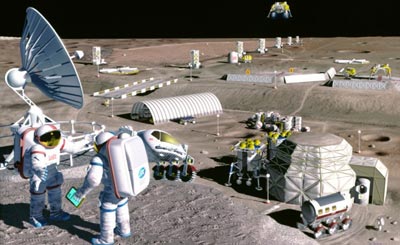The post-American Moonby Taylor Dinerman
|
| If a non-American base on the Moon is established, what will it look like to future American leaders? |
It is however, just a treaty. When the Germans invaded Belgium in 1914 in violation of a treaty that guaranteed Belgian neutrality, the Germans noted that the treaty was, to them, “just a scrap of paper.” Treaties are not self-enforcing: arms control treaties—and the OST is basically just that—have not been very successful in recent decades, with the Non Proliferation Treaty as just one example. These agreements are only effective as long as the world’s great powers are willing to enforce them or if they are basically insignificant. So far the OST has fallen into the later category.
However, within the next couple of decades that may change. In a fascinating interview with Jim Oberg, the president of the Planetary Society, Wesley T. Huntress, was asked if the cancellation of Constellation “means the end of dreams of human exploration of the Moon.” Huntress replied, “Others may go there and follow in out footsteps of long ago. Best of luck to them.” His reply is full of powerful implications. It not only reflects the fact that under the new program the US admits that it is incapable of going back to the Moon, but it also implies that we should basically ignore “others” should they establish a base on the Moon.
If a non-American base on the Moon is established, what will it look like to future American leaders? It might be a fully transparent, international, base on the model of the International Space Station (ISS), but without US participation. If so, will the US be comfortable with a base whose primary partners are the Russians and the Chinese with, say, minimal European participation? On the other hand, if such a base is less than fully open what will this imply?
| A good future model for lunar governance would be the Antarctic Treaty, which has kept the peace on that continent for more than half a century. |
Any Moon base would, at least superficially, resemble the kind of military base that is expressly prohibited by the OST. It will have to be buried in order to shield it from solar radiation and cosmic rays, which of course implies that it will be “fortified”. Its supply and transportation system could easily be considered a “dual use” technology since any transport vehicle traveling between the Earth and the Moon could be used as an anti-satellite (ASAT) weapon. An in situ resource utilization (ISRU) complex that provided liquid oxygen and liquid hydrogen could also provide fuel for military space vehicles of all sorts.
The Moon has been described as a “Gibraltar Point” in the Solar System. Unlike Gibraltar it is far less vulnerable and, with ISRU and access to the abundant water resources that we now know are up there, a base there could be far more self-sustaining than the British naval base that played such an important role in the military history of the 18th through 20th centuries.
If the US had gone ahead and built a similar base other nations would, naturally, have expressed similar fears about it. This may be why a few experts believe that a good future model for lunar governance would be the Antarctic Treaty, which has kept the peace on that continent for more than half a century. All the worlds major power and almost all the regional states have research stations there that perform valuable scientific work and also, with military logistical support, keep a close watch on each other to insure that no one is building an effective warfighting base.
By 2030 or 2040 it may not matter if the US has flown manned missions to the Lagrange points or asteroids or not; the world’s predominant military space power will be the one with a base on the Moon. Whether that base is officially military or not within the meaning of the OST is irrelevant. Nations that lack such a base will find themselves in an inferior military position to those who do.
